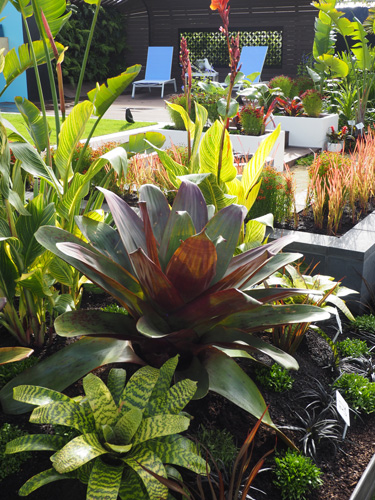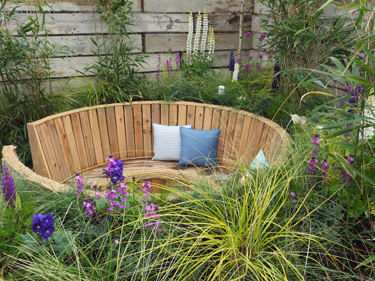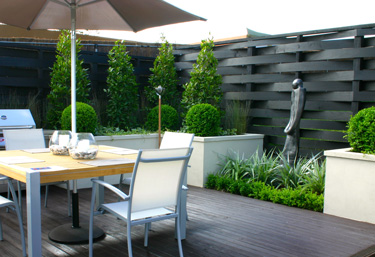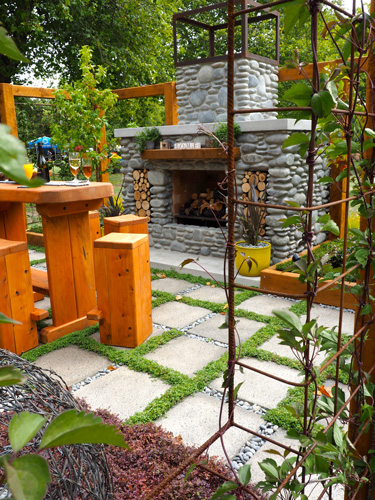The room outside
Outdoor living is part of the kiwi way of life, especially when summer comes around.
Whether it’s a ten-minute coffee break to soak up some vitamin D, or a long summer evening with friends, stepping outdoors into an inviting open-air living room brings that wonderful holiday feeling without having to travel.
These days, the huge range of modern landscaping materials and outdoor furnishings available means outdoor living spaces can get as high-end as kitchens and living rooms. But while it makes sense to devote as much time and expense to the outdoor room we spend so much time in, much can be done on a more modest budget.
Plan with purpose
It’s a matter of looking out how you use your space and deciding what’s most important. If entertaining is your main focus, top quality paving, heating and lighting might be high on your list of priorities. You may go as far as an outdoor kitchen or built-in fireplace.
If your outdoors is mainly a place for one or two, to relax and unwind with a book, you’ll want a comfortable intimate space with protection from the elements - and plants for that all-important connection with nature. For families with young children or pets a safe play area is critical. But if there is a park within walking distance, it doesn’t necessarily have to include a lawn.
If you love to grow food, your outdoor living area may double as your edible garden, in which case space for healthy soil will be a priority.
Walls
Whatever the main function, almost everyone wants an outdoor living space that’s private, away from the prying eyes of neighbours and passers by. The walls of your outdoor living room also provide shelter from chilly winds.
When the boundary fence isn’t tall enough to give you the privacy you need, placing a screen closer in to the sitting area can block a higher line of sight. Internal screens can also be taller than the usual 1.8m allowed for a property boundary.
A hedge is the ultimate garden wall, providing a beautiful living screen of foliage, but hedges take time to grow and they need regular trimming. They also take up more space than a fence and take moisture and nutrients away from other plants. When space is tight and time is short, a fence or trellis provides instant results and can be softened with a quick growing climber. Inexpensive screens can be a useful stopgap while you wait for trees and shrubs to grow.
The ‘green wall’ concept is a growing trend in both public and private spaces, where lots of individual plants completely cover the wall, with their roots in a vertically supported growing medium. To last the distance these need careful engineering and an integrated watering system. There are various green wall systems now available to home gardeners. However, evergreen climbers with their roots in the ground give a similar effect that is infinitely cheaper and easier to achieve.
Floors
A hard surface underfoot may be the most expensive element of your outdoor room, but well laid paving or decking are assets that last and employing an expert to do the job is the worth the expense. Professionally installed or DIY, there are lots of decisions to make. Drainage is very important when laying paving or concrete and a professional landscape contractor should take particular care of this when laying the foundations. Check the permeability guidelines with your local council to ensure the amount of surfacing you intend creating is legal.
If lawn is to feature in your outdoor room, hardwearing, low maintenance grasses are ideal. Give your lawn a well-defined shape, and ideally frame it with a neat mowing edge as a border to garden beds. Low creeping groundcover plants provide an alternative green carpet that doesn’t need mowing. They’re not so tolerant of foot traffic as a hardwearing lawn, but they’re great in combination with pavers.
Shade cover
If you are lucky, your living space might be shaded with a beautiful spreading tree, but there are many other ways to create that all-important protection from the sun’s rays. It may be as simple as making space for a sun umbrella or two. When budget permits, there is a choice of retractable awnings and automated louver roof systems on the market these days. Or you could construct a strong timber pergola for a beautiful deciduous climber that will give you shade in summer but let the sun through in winter. Climbers with hanging fruits and flowers can be especially beautiful over a pergola, even though they create a certain amount of litter.
It is important that any structure, be it screen, fence or pergola, is strong enough for your chosen climber. Be sure to make pergolas tall enough to accommodate the plants. A pergola that’s too low can be quite oppressive and make a space feel cramped.
A quick phone call or check of your local Council website should tell you whether or not you need to apply for a permit for the pergola, deck or outdoor fireplace you wish to build.
Deciduous climbers
Rambling roses, Bougainvillea, Clematis, Campsis (trumpet vine), Vitis vinifera (Ornamental grape), Wisteria.
Evergreen climbers
Beaumontia, Clematis paniculata, Dipladenia, Mandevilla, Passionfruit, Pyrostegia (flame vine), Tecomanthe, Trachelospermum (Star Jasmine)
Shade trees
Acer (Japanese maple), Alectryon (Titoki), Fraxinus (Ash), Ginkgo, Gleditsia, Jacaranda, Melia, Palms,
Prunus (flowering cherry), Robinia, Sophora (Kowhai).
Screens and hedges
Camellia, Corokia, Coprosma, Cupressocyparis, Escallonia, Griselinia, Michelia, Olearia, Pittosporum, Podocarpus totara, Syzygium, Thuja.
Ground carpets
Acaena (purple bidibidi), chamomile, Dichondra, Leptinella, Ophiopogon (mondo grass), Pratia, Scleranthus, thyme.
Design tips
- Consider the scale of the house when installing decks or paving. Be as generous as you can and allow plenty of room to move around tables and chairs. Do you need extra space for tricycle riders?
- Balance hard surfacing areas with planting.
- Large pavers can make a small area appear larger if you stick to one colour. Conversely, small pavers or bricks can look cluttered in a large area but they do make attractive edging or decorative detail.
- Combining contrasting textures, such as timber with concrete or paving with pebbles, adds interest, but be careful not to use too many different materials in one area. Any more than three can look cluttered.
- White or pale colours can be too glary in a sunny space. Dark paving can get too hot to walk on. Save bright colours for edging and detail.
- Choose materials to suit your house and garden. For a rustic style, go for warm earthy browns and reds or combine paving with rustic timber. In a modern contemporary setting, bold lines and cool sophisticated colours work well. Natural stone suits a subtropical garden, while earthy sandstone or coloured mosaics look great in a sun soaked Mediterranean style garden.
4-Nov-2015






